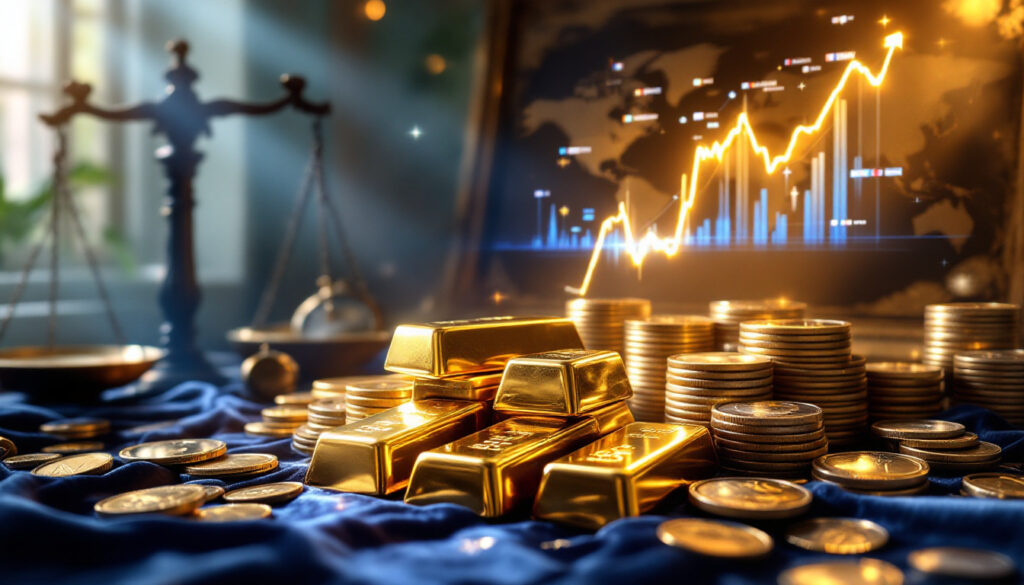What Makes Gold and Silver Valuable Investment Assets?
The Historical Significance of Precious Metals
Gold and silver have stood the test of time as stores of value across civilizations spanning thousands of years. These precious metals have maintained their purchasing power through centuries of economic upheavals, currency collapses, and geopolitical shifts that have rendered countless paper currencies worthless.
While modern currencies rely on government backing, gold and silver derive their value from physical scarcity and universal recognition. Archaeological evidence shows gold being used for ornamentation and trade as far back as 4000 BCE in Eastern Europe, while silver coins became the foundation of monetary systems in ancient Greece and Rome.
The enduring appeal of these metals stems from their unique properties: they don't corrode, can be melted and reformed without losing value, and exist in limited supply. Unlike modern currencies that can be created through monetary policy decisions, the world's gold supply grows by only about 1.5% annually through mining efforts.
Current Market Dynamics Driving Precious Metal Prices
The precious metals market has demonstrated remarkable strength in recent years, with gold reaching an all-time high of approximately $3,500 per ounce in April 2022. Since then, prices have consolidated within a trading range of $3,100-$3,400, reflecting a market digesting significant gains while establishing new support levels.
One of the most significant metrics for precious metals investors is the gold-silver ratio analysis, which recently reached approximately 100:1. This means it takes 100 ounces of silver to purchase a single ounce of gold—a ratio far above the historical average of 60:1 and suggesting potential undervaluation of silver.
Several key factors are currently influencing price volatility in precious metals:
- Central bank purchases: Nations like China, Russia, and India have accelerated their gold acquisition programs.
- Inflation concerns: Rising consumer prices globally have enhanced gold as an inflation hedge.
- Geopolitical tensions: Conflicts and trade disputes have increased safe-haven demand.
- Industrial demand for silver: Renewable energy and electronics manufacturing require increasing silver inputs.
How Does Gold Perform in Today's Economic Climate?
Gold's Recent Price Performance and Patterns
Gold's performance from 2023 through early 2025 has been characterized by steady gains punctuated by periods of consolidation. After breaking through psychological resistance at $2,000 in late 2023, gold accelerated its upward trajectory, eventually reaching its April 2022 peak of $3,500—a move representing a 75% increase from its 2023 starting point.
Following this significant rally, gold experienced a healthy pullback of approximately $380 (from $3,500 to $3,120), representing a standard technical correction of roughly 11%. This retracement established crucial support around the $3,120 level, which has held during subsequent tests.
Currently, gold faces resistance at the $3,360 downtrend line formed from the April peak. Technical analysis suggests a period of consolidation may continue, with price action forming a narrowing triangle pattern that typically precedes a significant directional move.
Seasonal Patterns in Gold Trading
Seasonal analysis reveals consistent patterns in gold's price behavior throughout calendar years. The metal typically experiences strength from January through May, often forming a seasonal top in the March-May timeframe. This pattern has aligned perfectly with 2022's April peak.
June has historically been gold's weakest month, with an average decline of 1.2% over the past 25 years. This seasonal weakness often creates optimal entry points for long-term investors.
The period from mid-June to mid-July frequently represents a turning point in gold's annual cycle, with the second half of the year typically providing stronger returns than the first—a pattern gold traders refer to as the "summer doldrums" followed by "fall acceleration."
These seasonal trends appear to be playing out on schedule in the current market cycle, suggesting potential buying opportunities may emerge in the coming weeks for investors looking to establish or add to positions before the next potential upleg.
What Are the Price Targets for Gold Through 2025?
Short-Term Gold Price Projections
From a technical perspective, the recent establishment of solid support at the $3,120 level provides a foundation for future price movements. Multiple tests of this level have reinforced its significance as a key floor in the current trading range.
Market analysts are closely watching the $3,420 price gap that remains to be filled—a common technical phenomenon where prices eventually return to "fill" areas where trading activity was limited or skipped entirely during rapid price movements.
In the near term, sideways trading within the $3,100-$3,400 range appears likely as the market builds energy for its next directional move. Volume patterns show decreasing selling pressure on dips toward support, suggesting accumulation by larger investors and institutions.
Key resistance levels to monitor include:
- $3,360: The current downtrend line from April's peak
- $3,420: The unfilled gap that represents immediate upside potential
- $3,500: The previous all-time high, which will require significant momentum to breach
Long-Term Gold Price Forecasts
Looking beyond current consolidation, several factors point to potentially higher gold prices through 2025 and beyond. The psychological price targets of $4,000 and $5,000 represent significant milestones that may be achieved as monetary and geopolitical trends continue to favor precious metals.
The longer-term case for gold strength is built on several fundamental pillars:
- Central bank diversification: Nations continue reducing dollar exposure in favor of gold reserves.
- Fiscal imbalances: Growing government debt burdens historically correlate with higher gold prices.
- Supply constraints: Peak gold production may have already occurred, with major discoveries becoming increasingly rare.
- Institutional adoption: Asset managers are increasing allocations to precious metals as portfolio diversifiers.
While price projections involve uncertainty, the current consolidation phase following gold's move to $3,500 appears consistent with previous bull market patterns, where periods of digestion precede even stronger advances. According to gold price forecast insights, the second half of 2025 may see gold challenging new all-time highs if current fundamental drivers remain intact.
Disclaimer: Price projections are speculative and based on current market conditions. Investors should conduct their own research and consider their individual financial situations before making investment decisions.
Why Is Silver Currently Undervalued?
Understanding the Gold-Silver Ratio
The gold-silver ratio stands as one of the most compelling metrics pointing to silver's potential undervaluation. At approximately 100:1, this ratio has reached extreme levels compared to its historical norms. For context, the gold-silver ratio has averaged closer to 60:1 over the past century, and during precious metals bull markets, it has frequently compressed to 30:1 or lower.
Geological data provides additional perspective—silver occurs in the earth's crust at a ratio of approximately 17:1 compared to gold. Yet the current market pricing reflects a valuation gap nearly six times wider than this natural abundance ratio.
Silver typically lags gold in the early stages of precious metals bull markets for several reasons:
- Gold is purchased first as a monetary hedge by institutional investors
- Silver's industrial demand component makes it initially more sensitive to economic concerns
- Silver's market is much smaller, requiring less capital to move significantly once momentum builds
Historical patterns suggest that once silver begins its catch-up phase, it frequently outperforms gold by a factor of 2-3×. This dynamic has led many analysts to project potential silver prices of $50 per ounce or higher if the current precious metals bull market follows previous cycles.
Silver's Industrial Demand vs. Investment Appeal
Silver's unique position as both an industrial metal and an investment asset creates a compelling supply-demand dynamic not present with gold. While approximately 60% of annual silver production goes to industrial applications, this percentage continues to grow with technological advancement.
Critical industrial applications driving fundamental demand include:
- Solar panel production: Each solar panel contains approximately 20 grams of silver
- Electric vehicles: The average EV uses about 25-50 grams of silver in various components
- Electronics: Silver's superior conductivity makes it essential in smartphones, tablets, and computers
- Medical applications: Silver's antimicrobial properties drive usage in specialized medical devices
This industrial demand continues to grow while silver mine supply has actually declined in recent years. Primary silver mines (where silver is the main product) have become increasingly rare, with most silver now produced as a byproduct of copper, lead, and zinc mining operations.
When investment demand accelerates—as typically happens later in precious metals bull markets—this creates a potential silver market transformation where industrial users compete with investors for available metal. This dynamic has historically led to dramatic price increases once silver begins outperforming gold.
What Strategies Work Best for New Precious Metals Investors?
Building a Precious Metals Portfolio
For investors new to precious metals, developing a systematic approach proves more effective than attempting to time perfect market entry points. Rather than making a single large purchase, consider implementing a dollar-cost averaging strategy with regular acquisitions regardless of short-term price fluctuations.
Beginning with physical metals provides a foundational understanding of the market before exploring more complex investment vehicles. A balanced approach might include:
- Silver coins/small bars: For accessibility and divisibility
- Gold in smaller denominations: 1/10 oz or 1/4 oz coins to build positions gradually
- Proportional allocation: Consider a 60/40 or 70/30 gold-to-silver ratio by value to balance stability with growth potential
As your portfolio grows, consider diversifying across different forms of precious metals exposure:
- Physical metals: For direct ownership and crisis protection
- Mining stocks: For potential leverage to metal price increases
- ETFs: For liquidity and ease of trading
- Royalty/streaming companies: For exposure to mining profits with reduced operational risk
The ideal allocation to precious metals varies based on individual circumstances, but many financial advisors suggest 5-15% of investable assets as appropriate for most investors seeking portfolio diversification. For detailed information on getting started, the Perth Mint's investing guide provides valuable insights for beginners.
Common Mistakes to Avoid When Investing in Precious Metals
New precious metals investors frequently encounter several pitfalls that can significantly impact their returns. Being aware of these common mistakes can improve long-term outcomes:
Using leverage in precious metals investments: While borrowing to invest can amplify returns in rising markets, it can be devastating during normal market corrections. Precious metals exhibit sufficient volatility on their own without adding the risk of margin calls or forced liquidation.
Waiting for "perfect" entry points: Many investors delay initial purchases while waiting for lower prices, often missing substantial moves higher. Historical data shows that systematic buying regardless of short-term price movements typically outperforms attempts at precise market timing.
Viewing precious metals as short-term trades: Gold and silver perform best as long-term holdings (5+ years) rather than vehicles for quick profits. The strongest gains often come after extended consolidation periods that shake out impatient investors.
Overpaying through premium unawareness: Different products carry varying premiums above the metal's spot price. For example, rare or collectible coins often command premiums of 30% or more above metal value, while standard bullion products typically sell for 3-8% over spot. Understanding these premium differences prevents overpayment for unnecessary numismatic value.
How Might Gold Re-enter the Global Financial System?
The Potential for Gold-Backed Currencies
Recent years have seen increasing discussions and initiatives around reintroducing gold into monetary systems after decades of pure fiat currency arrangements. Several developments suggest this trend may accelerate:
China has established gold exchange facilities for trading partners participating in its Belt and Road Initiative, enabling direct settlement of international trade in gold rather than dollars. This system provides participating nations with a dollar alternative for international commerce.
Russia's two-decade gold accumulation program has significantly bolstered its reserves, with the Russian central bank purchasing nearly all domestic mining production. This strategy has coincided with Russia's reduced holdings of U.S. Treasury securities, indicating a deliberate diversification away from dollar-denominated assets.
U.S. gold import patterns have shown unusual activity, with large quantities of gold being imported from Switzerland and the U.K. in recent years. These movements suggest potential official sector activity beyond normal market operations.
While a return to a classical gold standard appears unlikely, various forms of partial gold backing for currencies have gained traction among monetary theorists and some policymakers. Even a fractional backing system—where currencies maintain partial gold reserves—would significantly impact gold valuations given current price levels.
Central Bank Digital Currencies and Gold
The development of Central Bank Digital Currencies (CBDCs) presents both challenges and opportunities for gold's monetary role. As many nations race to implement digital versions of their currencies, questions about their credibility and acceptance have emerged.
Fiat currencies worldwide face unprecedented credibility challenges after extended periods of monetary expansion. The global money supply has increased dramatically since 2008, with another acceleration during the pandemic response of 2020-2021. This expansion has eroded purchasing power and heightened concerns about currency stability.
Some financial analysts suggest nations might use gold backing to enhance the credibility and acceptance of newly introduced CBDCs. This approach would address trust issues inherent in purely digital currencies while leveraging blockchain technology's accounting transparency.
The possibility of partial gold backing for government debt instruments has also gained attention as sovereign debt levels reach historic highs relative to GDP. Even a modest gold backing percentage would require significantly higher gold valuations to align with outstanding obligations.
A competitive landscape has emerged between major economic powers regarding gold monetization. Nations acquiring substantial gold reserves position themselves advantageously should monetary reset scenarios develop, while those with minimal reserves face potential disadvantages in future negotiations.
What External Factors Impact Precious Metals Markets?
Geopolitical Influences on Gold and Silver Prices
Geopolitical developments consistently rank among the most significant drivers of precious metals price movements. International tensions create uncertainty that typically benefits safe-haven assets like gold and silver.
Recent examples demonstrate this relationship:
- Military conflicts have triggered rapid gold price increases of 3-5% within days of escalation
- Trade dispute announcements between major economies correlate with increased precious metals buying
- Currency devaluation events in emerging markets lead investors to seek precious metals protection
Regional conflicts affect precious metals through several mechanisms:
- Disruption of mining operations in affected areas
- Increased government purchasing of gold as strategic reserves
- Capital flight from affected regions into portable wealth forms
- Heightened general uncertainty driving safe-haven demand
The intensity of geopolitical premium in gold prices varies considerably, ranging from minimal during periods of relative stability to as much as $200-300 per ounce during acute international crises. This premium tends to build quickly but dissipate gradually as situations stabilize.
Monetary Policy Effects on Precious Metals
The relationship between monetary policy decisions and precious metals performance provides critical context for investors. Historically, periods of monetary expansion correlate strongly with rising precious metals valuations.
M2 money supply growth—a broad measure of currency and near-money assets in circulation—has shown particularly strong correlation with gold prices over multi-year timeframes. When money supply grows faster than economic output, gold typically appreciates against that currency.
Central bank policies that have historically benefited gold and silver include:
- Interest rate reductions that lower the opportunity cost of holding non-yielding assets
- Quantitative easing programs that expand balance sheets
- Forward guidance suggesting extended periods of accommodative policy
- Direct asset purchases that suppress bond yields
Some economists have revived interest in the "Crack-Up Boom" theory originally proposed by Ludwig von Mises, which describes an acceleration phase of inflation where the public loses confidence in currency, triggering rapid conversion to tangible assets. This scenario would create particularly favorable conditions for precious metals performance.
How Can Investors Generate Income from Gold Holdings?
Productive Uses for Physical Gold
Traditional gold ownership involves storage costs without income generation, but alternative approaches have emerged that transform gold from a static holding to a potentially productive asset.
Gold leasing programs offered through certain specialized bullion dealers and private arrangements provide yields ranging from 2-5% annually. These programs lend physical gold to commercial users who require metal for manufacturing processes, creating an interest stream for the metal owner.
For accredited investors meeting regulatory requirements, structured programs exist offering returns up to 12% on silver paid in additional silver rather than currency. These higher-yield arrangements typically involve supplying working capital to refiners or fabricators with physical metal as collateral.
The transformation of gold from a storage cost to an income-producing asset represents a significant evolution in precious metals ownership. While these arrangements introduce counterparty risk not present in direct ownership, they provide options for investors seeking both preservation of purchasing power and income generation.
When evaluating such programs, investors should carefully assess the security arrangements, business model sustainability, and regulatory compliance of the offering entity. The highest-yielding programs typically involve the greatest risk, making thorough due diligence essential.
FAQs About Silver and Gold Investing
Is now a good time to buy gold or silver?
Timing precious metals markets perfectly challenges even experienced investors. Rather than seeking optimal entry points, consider the role these assets play in your overall financial strategy.
Current market conditions present both supportive and cautionary factors:
Supportive factors:
- Global monetary expansion continues at historically elevated levels
- Geopolitical tensions show few signs of sustained resolution
- Physical metal demand remains strong
Ready to Catch the Next Major Mineral Discovery?
Discover why significant ASX mineral discoveries can lead to exceptional market returns with Discovery Alert's proprietary Discovery IQ model, which instantly analyses daily announcements to identify high-potential opportunities. Explore historic examples of exceptional investment outcomes by visiting Discovery Alert's dedicated discoveries page and gain your market-leading advantage today.




